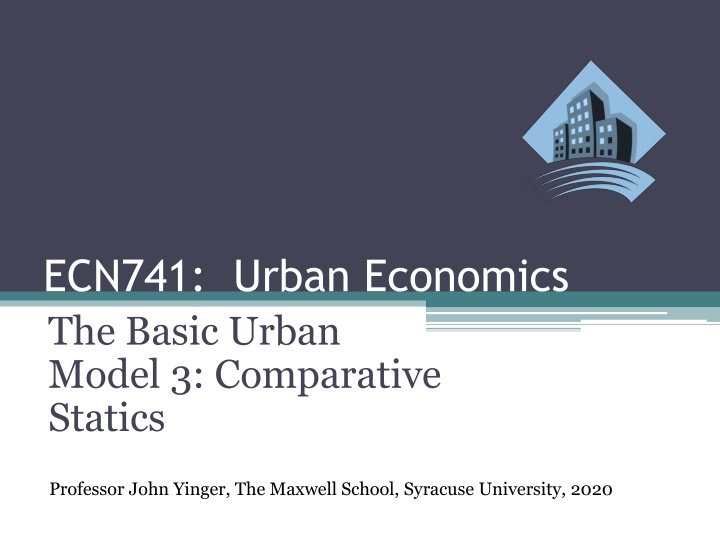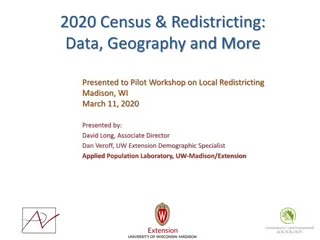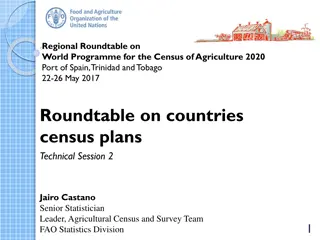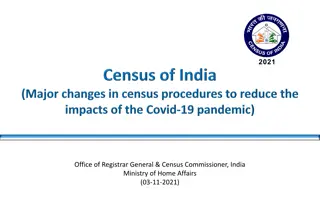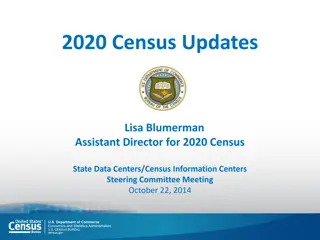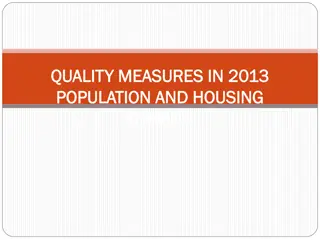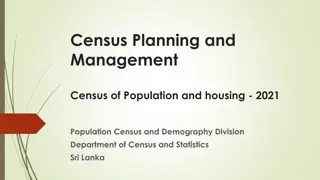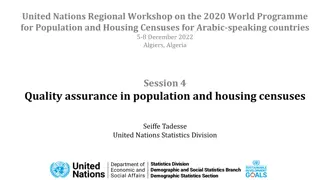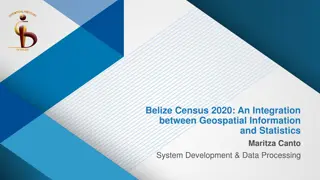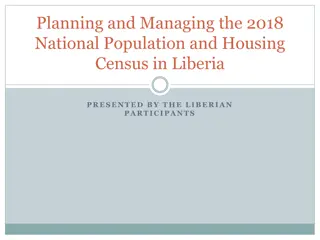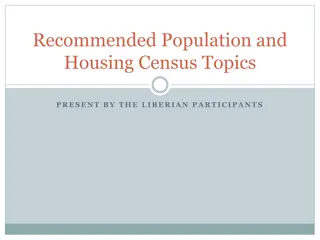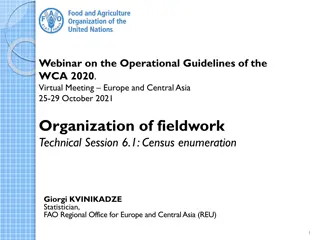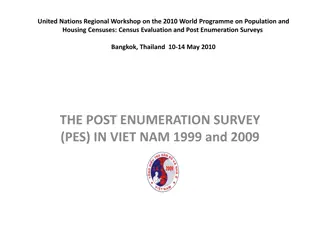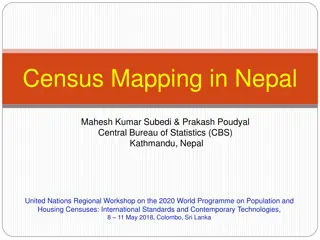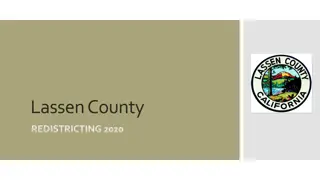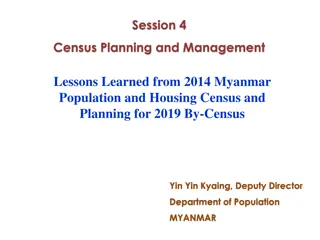Enhancing Transitory Locations for Decennial Census Planning
Investigate and validate transitory location frames for Decennial census planning using web scraping and predictive modeling. Augmenting RV park data to improve enumeration coverage. Scraper development and information collection process outlined.
Download Presentation

Please find below an Image/Link to download the presentation.
The content on the website is provided AS IS for your information and personal use only. It may not be sold, licensed, or shared on other websites without obtaining consent from the author.If you encounter any issues during the download, it is possible that the publisher has removed the file from their server.
You are allowed to download the files provided on this website for personal or commercial use, subject to the condition that they are used lawfully. All files are the property of their respective owners.
The content on the website is provided AS IS for your information and personal use only. It may not be sold, licensed, or shared on other websites without obtaining consent from the author.
E N D
Presentation Transcript
ECN741: Urban Economics The Basic Urban Model 3: Comparative Statics Professor John Yinger, The Maxwell School, Syracuse University, 2020
The Basic Urban Model Class Outline 1. The point of comparative statics and how to do it 2. Open model comparative statics results 3. Closed model comparative statics results 4. Comparative statics graphs
The Basic Urban Model Class Outline 1. The point of comparative statics and how to do it 2. Open model comparative statics results 3. Closed model comparative statics results 4. Comparative statics graphs
The Basic Urban Model Why Comparative Statics? Urban models describe urban residential structure when (simplified!) models of 6 markets are combined. A key set of questions involves the way urban residential structure changes when one of the parameters of the model changes. Comparative statics is a method to find the derivatives of the variables in the model with respect to key parameters accounting for interactions across markets.
The Basic Urban Model Why Comparative Statics, 2? Key parameters include Y, t, , U* (open), and N (closed). R With the basic model we can ask what happens to urban residential structure when incomes rise over time; transportation innovation or investment takes place; the cost of non-urban activity (e.g. agriculture) changes; the situation in one city changes (or the opportunities in other cities change); or population increases everywhere (or in one city where out- migration does not occur).
The Basic Urban Model How To Do Comparative Statics Comparative statics (CS) results are based on total derivatives, not partial derivatives. CS results must account for all the variables in one of the equations we have derived. For example, many of the equations in the model, including equations for R{u}, P{u}, and D{u}, can be expressed as a function of the parameters and only one variable, namely, . u
The Basic Urban Model How to Do Comparative Statics, 2 In these cases, CS derivations are based on equation like this one for R{u}: dR u R u d R u u du d = + In this equation, can be any of the model s parameters (at least any of the ones that appear in the R{u} equation!). A key to finding many CS derivatives, therefore, is to find the impact of the relevant parameter on . u
The Basic Urban Model Class Outline 1. The point of comparative statics and how to do it 2. Open model comparative statics results 3. Closed model comparative statics results 4. Comparative statics graphs
The Basic Urban Model Open Model Comparative Statics Most CS results are relatively easy to obtain with an open model because of the form taken by the indirect utility function: ( ) * k Y tu U P ( ) k Y tu = = a R C or * * a P U k t R U C k t Y Y = = u
The Basic Urban Model Open Model Comparative Statics, 2 u In this formulation, is on the left side of the equation and all the key parameters are on the right. So it is straightforward to derive CS results for the impact of all these parameters on . u These results can then be inserted into the formula given earlier to find CS results for R{u} and other variables.
The Basic Urban Model Open Model Comparative Statics, 3 From * * a P U k t R U C k t Y Y = = u We can see that du dY 1 t du dt u t = = 0 ; 0 1 a a * d u d U P kt d u dR a U R k t C = = 0; 0 *
The Basic Urban Model Open Model Comparative Statics, 4 So the physical size of an urban area: Increases when income rises. Decreases when commuting costs rise. Decreases when opportunities improve elsewhere. Decreases when agriculture becomes more profitable.
The Basic Urban Model Open Model Comparative Statics, 5 Now take the expression for R{u} 1 a Y Y tu tu R u = R To find the CS derivative for Y, differentiate with respect to Y, recognizing that Y affects , and plug in the above result for d /dY. The result: u u R u Y tu d R u d Y = 0 ( ) a
The Basic Urban Model Open Model Comparative Statics, 5 Similarly, we can start with the expression for N = + + 1 b R Y Y t b tu + N u ( ) ( )( ) b 1 t 1 t b Y tu Then we can differentiate with respect to Y, recognizing that Y affects , and plug in the above result for d /dY. This yields: = u u b d N d Y R t Y 1 0 ( ) b 2 Y tu
The Basic Urban Model Open Model Comparative Statics Table Parameter R Variable Y t U* - + - - u + - 0 - R{u} or P{u} or D{u} N - + - -
The Basic Urban Model Class Outline 1. The point of comparative statics and how to do it 2. Open model comparative statics results 3. Closed model comparative statics results 4. Comparative statics graphs
The Basic Urban Model Closed Model Comparative Statics In a closed model, the derivatives of with respect to the parameters come from the population equation, now with a bar over the N: u + 1 b R Y Y t b tu + = N u ( ) ( )( ) b 1 t + 1 t b Y tu This equation is messier than the one for an open model, but its nonlinearity does not get in the way of CS as it does for solving the model.
The Basic Urban Model Closed Model Comparative Statics, 2 For example, after a little algebra one can show that: ( ) 2 dR R b + 1 t b N 1 du = 0 + 1 b Y 1 Y tu Not surprisingly, increasing agricultural rents shrinks the urban area. Recall: b = 1/a .
The Basic Urban Model Closed Model Comparative Statics, 3 To find the CS derivative , we must substitute this result into: 1 d R R { }/ dR u dR d R u R u tbR Y du dR = + 0 tu The result (derive as an exercise) indicates, not surprisingly, that more competition for land squeezes an urban area and pushes up rents (and density) until there is enough room for the population in a smaller space.
The Basic Urban Model Closed Model Comparative Statics Table Parameter t - small u:+ large u: - - Variable u Y + N + + R - + small u:- large u:+ + R{u} or P{u} or D{u} - - U*
The Basic Urban Model Class Outline 1. The point of comparative statics and how to do it 2. Open model comparative statics results 3. Closed model comparative statics results 4. Comparative statics graphs
The Basic Urban Model Comparative Statics Intuition We can develop an intuition for these results with some simple graphs for R{u} (or P{u} or D{u}). To interpret these graphs note that u Population depends on density and urban size (= ). A change in Y flattens P{u}and R{u} (remember, P {u}= -t/H and H depends on Y). An increase in t steepens R{u}.
The Basic Urban Model CS Result for Y Open Model Closed Model With city size increase, density cannot increase at all locations R must rise at R{u} R{u} u=0 because utility is fixed Density declines near center Density increases in suburbs, which grow R R 2 u 2 u 1u 1u u u
The Basic Urban Model CS Result for t Open Model Closed Model With city size decrease, density cannot decrease at all locations R does not change at R{u} R{u} u=0 because tu=0. Density goes up in the center and down in the suburbs, which shrink. R R 1u 2 u 2 u 1u u u
The Basic Urban Model CS Result for R Open Model Closed Model City size and density cannot both move in the same direction Utility level R{u} R{u} (indexed by height of R{u}) cannot change R R 1 R Implies higher density every- where 2 2 1 R 1u 2 u 2 u 1u u u
The Basic Urban Model Other CS Results Open Model (U*) Closed Model (N) R{u} R{u} City shrinks and becomes less dense City grows and becomes more dense R R 1u 2 u 2 u 1u u u
The Basic Urban Model Informal Tests of CS Results These results predict that cities will get less dense in the center, more dense in the suburbs, and larger as incomes rise and transportation costs fall. Many estimates of population density functions for cities around the world find this to be true. But the models have only one worksite and many other simplifications. Is this just a lucky coincidence or do the models capture something fundamental?
The Basic Urban Model Questions What can we learn from comparative static analysis of an urban model? What are the differences between comparative statics results for open and closed models?
